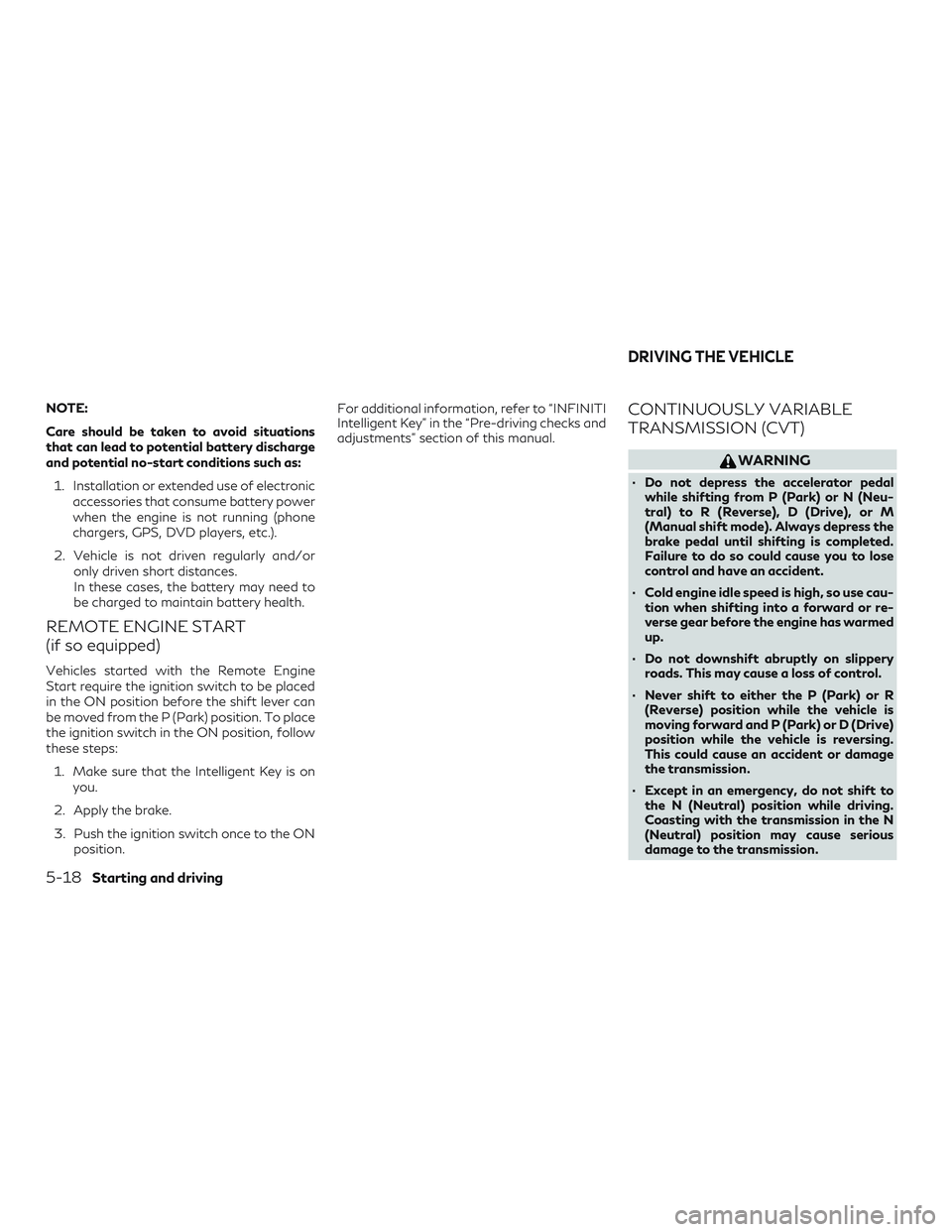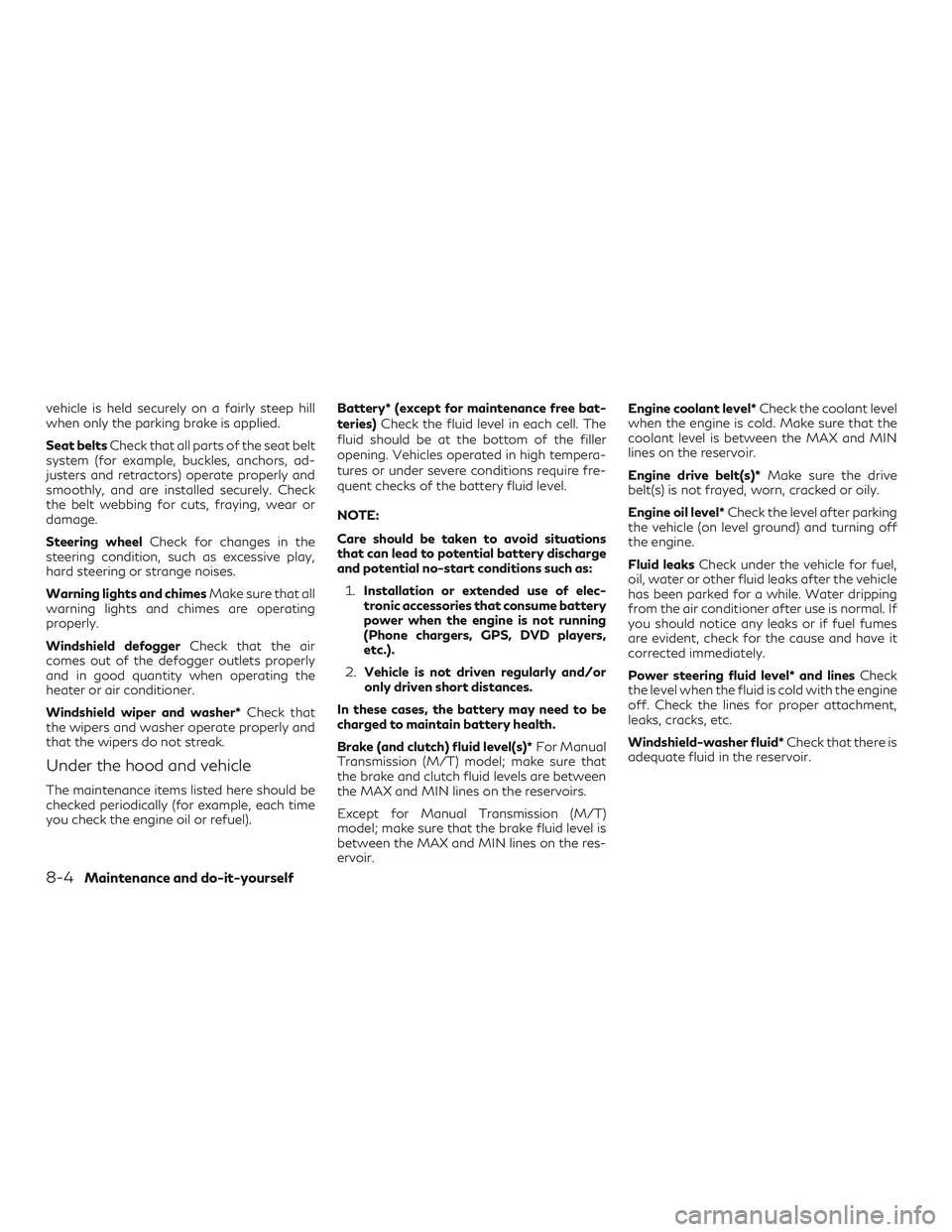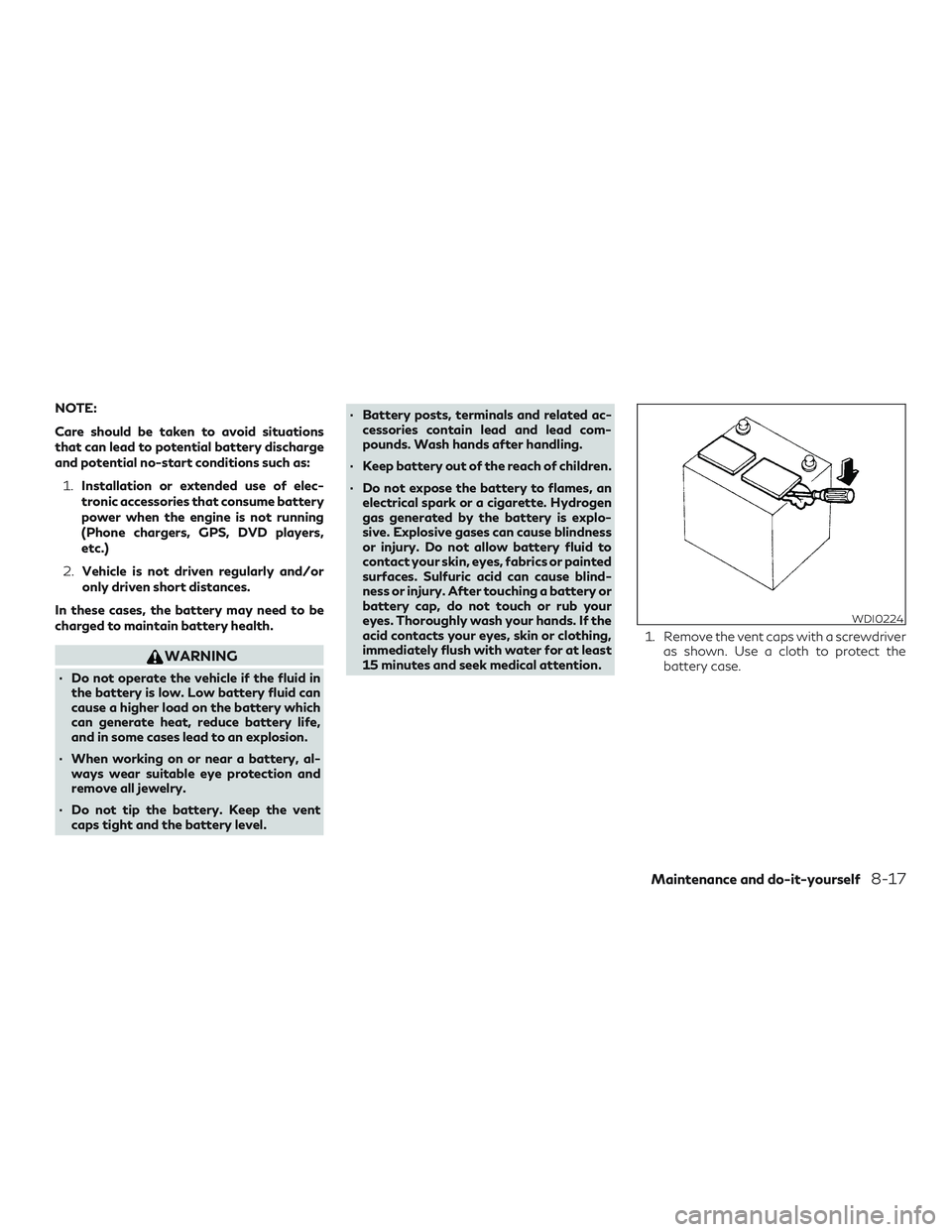CD player INFINITI QX60 2018 Owners Manual
[x] Cancel search | Manufacturer: INFINITI, Model Year: 2018, Model line: QX60, Model: INFINITI QX60 2018Pages: 490, PDF Size: 6.34 MB
Page 265 of 490

NOTE:
Care should be taken to avoid situations
that can lead to potential battery discharge
and potential no-start conditions such as:1. Installation or extended use of electronic accessories that consume battery power
when the engine is not running (phone
chargers, GPS, DVD players, etc.).
2. Vehicle is not driven regularly and/or only driven short distances.
In these cases, the battery may need to
be charged to maintain battery health.
REMOTE ENGINE START
(if so equipped)
Vehicles started with the Remote Engine
Start require the ignition switch to be placed
in the ON position before the shift lever can
be moved from the P (Park) position. To place
the ignition switch in the ON position, follow
these steps:
1. Make sure that the Intelligent Key is on you.
2. Apply the brake.
3. Push the ignition switch once to the ON position. For additional information, refer to “INFINITI
Intelligent Key” in the “Pre-driving checks and
adjustments” section of this manual.
CONTINUOUSLY VARIABLE
TRANSMISSION (CVT)
WARNING
∙ Do not depress the accelerator pedal
while shifting from P (Park) or N (Neu-
tral) to R (Reverse), D (Drive), or M
(Manual shift mode). Always depress the
brake pedal until shifting is completed.
Failure to do so could cause you to lose
control and have an accident.
∙ Cold engine idle speed is high, so use cau- tion when shifting into a forward or re-
verse gear before the engine has warmed
up.
∙ Do not downshift abruptly on slippery roads. This may cause a loss of control.
∙ Never shift to either the P (Park) or R (Reverse) position while the vehicle is
moving forward and P (Park) or D (Drive)
position while the vehicle is reversing.
This could cause an accident or damage
the transmission.
∙ Except in an emergency, do not shift to the N (Neutral) position while driving.
Coasting with the transmission in the N
(Neutral) position may cause serious
damage to the transmission.
DRIVING THE VEHICLE
5-18Starting and driving
Page 429 of 490

vehicle is held securely on a fairly steep hill
when only the parking brake is applied.
Seat beltsCheck that all parts of the seat belt
system (for example, buckles, anchors, ad-
justers and retractors) operate properly and
smoothly, and are installed securely. Check
the belt webbing for cuts, fraying, wear or
damage.
Steering wheel Check for changes in the
steering condition, such as excessive play,
hard steering or strange noises.
Warning lights and chimes Make sure that all
warning lights and chimes are operating
properly.
Windshield defogger Check that the air
comes out of the defogger outlets properly
and in good quantity when operating the
heater or air conditioner.
Windshield wiper and washer* Check that
the wipers and washer operate properly and
that the wipers do not streak.
Under the hood and vehicle
The maintenance items listed here should be
checked periodically (for example, each time
you check the engine oil or refuel). Battery* (except for maintenance free bat-
teries)
Check the fluid level in each cell. The
fluid should be at the bottom of the filler
opening. Vehicles operated in high tempera-
tures or under severe conditions require fre-
quent checks of the battery fluid level.
NOTE:
Care should be taken to avoid situations
that can lead to potential battery discharge
and potential no-start conditions such as:
1. Installation or extended use of elec-
tronic accessories that consume battery
power when the engine is not running
(Phone chargers, GPS, DVD players,
etc.).
2. Vehicle is not driven regularly and/or
only driven short distances.
In these cases, the battery may need to be
charged to maintain battery health.
Brake (and clutch) fluid level(s)* For Manual
Transmission (M/T) model; make sure that
the brake and clutch fluid levels are between
the MAX and MIN lines on the reservoirs.
Except for Manual Transmission (M/T)
model; make sure that the brake fluid level is
between the MAX and MIN lines on the res-
ervoir. Engine coolant level*
Check the coolant level
when the engine is cold. Make sure that the
coolant level is between the MAX and MIN
lines on the reservoir.
Engine drive belt(s)* Make sure the drive
belt(s) is not frayed, worn, cracked or oily.
Engine oil level* Check the level after parking
the vehicle (on level ground) and turning off
the engine.
Fluid leaks Check under the vehicle for fuel,
oil, water or other fluid leaks after the vehicle
has been parked for a while. Water dripping
from the air conditioner after use is normal. If
you should notice any leaks or if fuel fumes
are evident, check for the cause and have it
corrected immediately.
Power steering fluid level* and lines Check
the level when the fluid is cold with the engine
off. Check the lines for proper attachment,
leaks, cracks, etc.
Windshield-washer fluid* Check that there is
adequate fluid in the reservoir.
8-4Maintenance and do-it-yourself
Page 442 of 490

NOTE:
Care should be taken to avoid situations
that can lead to potential battery discharge
and potential no-start conditions such as:1. Installation or extended use of elec-
tronic accessories that consume battery
power when the engine is not running
(Phone chargers, GPS, DVD players,
etc.)
2. Vehicle is not driven regularly and/or
only driven short distances.
In these cases, the battery may need to be
charged to maintain battery health.
WARNING
∙ Do not operate the vehicle if the fluid in the battery is low. Low battery fluid can
cause a higher load on the battery which
can generate heat, reduce battery life,
and in some cases lead to an explosion.
∙ When working on or near a battery, al- ways wear suitable eye protection and
remove all jewelry.
∙ Do not tip the battery. Keep the vent caps tight and the battery level. ∙ Battery posts, terminals and related ac-
cessories contain lead and lead com-
pounds. Wash hands after handling.
∙ Keep battery out of the reach of children.
∙ Do not expose the battery to flames, an electrical spark or a cigarette. Hydrogen
gas generated by the battery is explo-
sive. Explosive gases can cause blindness
or injury. Do not allow battery fluid to
contact your skin, eyes, fabrics or painted
surfaces. Sulfuric acid can cause blind-
ness or injury. After touching a battery or
battery cap, do not touch or rub your
eyes. Thoroughly wash your hands. If the
acid contacts your eyes, skin or clothing,
immediately flush with water for at least
15 minutes and seek medical attention. 1. Remove the vent caps with a screwdriver
as shown. Use a cloth to protect the
battery case.
WDI0224
Maintenance and do-it-yourself8-17